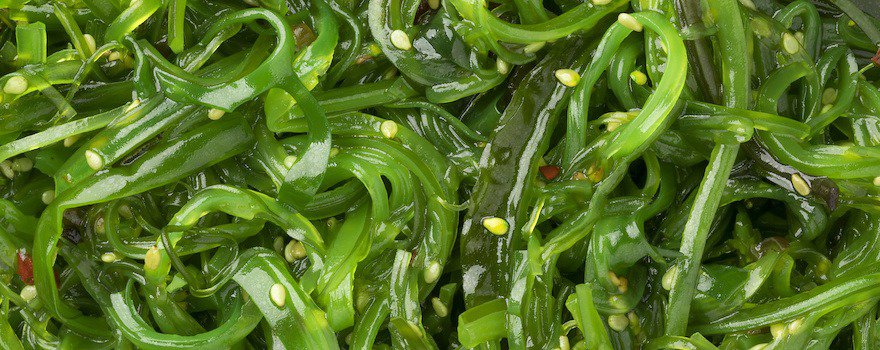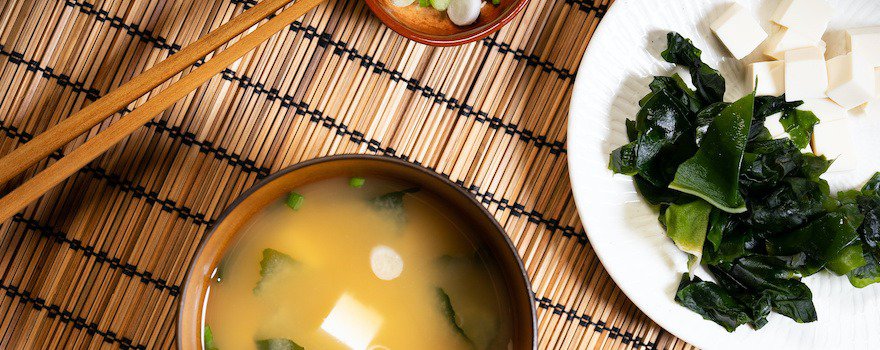BENEFITS OF WAKAME
✓ Very high in protein
✓ Improves diabetes
✓ Fights obesity
✓ Supports cardiovascular health
✓ Potentially anti-cancer
What is wakame?
Wakame, whose scientific name is Undaria pinnatifida, belongs to the family Alariaceae, which includes many brown algae. Native to Asia, it naturally grows on the temperate coasts of Japan, China, and Korea. It was later introduced to other regions of the world (Australia, the United States, and Europe), where it quickly acclimated.
This seaweed has a lanceolate shape and can reach up to 3 meters in length. Brownish-yellow in color, it is translucent, with cut and toothed edges. It has holdfasts, called haptera, which allow it to attach to rocks and a wide range of hard substrates.

Wakame generally grows at depths of 6 to 12 m. Like spirulina, klamath or chlorella, it performs photosynthesis thanks to the chlorophyll and pigments it contains. It then captures sunlight and converts it into organic matter to feed itself.
Also called « sea lettuce », wakame is a food typical of Japanese cuisine. It is commonly used in the preparation of soups, including the famous miso soup, in salads, sushi dishes or with tofu. It is also eaten cooked like spinach leaves.
Wakame is prized for its marine, slightly briny, iodine-like flavor, similar to that of oysters. Beyond its culinary and gustatory appeal, the seaweed is packed with nutrients.
Il se distingue surtout par sa teneur élevée en protéines végétales : 14 g pour 100 g. Il possède également une large palette de vitamines, renferme des fibres, des acides aminés, des acides gras et divers minéraux et oligo-éléments. Cette composition exceptionnelle lui confère de nombreux bienfaits sur la santé.
Wakame is, moreover, a staple food in the traditional Chinese medicine and Ayurvedic medicine. Various studies on the seaweed have highlighted its properties and helped to better understand its effects on the body. Wakame is, first and foremost, an interesting alternative to animal proteins. It is also credited with beneficial effects against diabetes and obesity.
Nutritional composition
- Acides aminés
- Vitamines : provitamine A, B1, B2, B3, B5, B6, B9, C, E, K
- Minéraux et oligo-éléments : sodium, calcium, fer, iode, magnésium, potassium, manganèse, cuivre, phosphore, zinc
- Protéines
- Lipides
- Glucides
- Fibres
- Polysaccharides : alginate, fucoïdane
- Pigments antioxydants : chlorophylle, fucoxanthine
- Acides gras : oméga 3

The benefits of wakame
🌿 Very high in protein
With 14 g of plant protein per 100 g, wakame is ideal as a substitute for animal-derived proteins. Its protein content is similar to that of quinoa but exceeds that of goji berries (12 g per 100 g), beans (9 g per 100 g) and cereals in general (8 g per 100 g).
Wakame therefore helps you get plenty of protein and avoid a potential protein deficiency, especially as part of a vegetarian diet. Remember that proteins are macronutrients essential for energy production and that they take part in many bodily functions : building and renewing cells, hormone regulation, immune defense production, muscle contraction…
Moreover, the proteins in this seaweed have good digestibility. Thus, the digestive system is able to absorb and break down a large portion (about 70%) of the proteins into amino acids. These proteins also offer notable bioavailability: 62% of the available energy is absorbed by the body.
This study from Tokushima University (Japan), conducted on adult men, examined the digestibility of wakame proteins.
🍭 Improves diabetes
Wakame is included among the superfoods that help fight diabetes. It does this by regulating blood glucose levels and improving insulin sensitivity.
On the one hand, wakame reduces blood glucose levels, notably postprandial glycemia (blood glucose level after a meal). Its effectiveness appears to be due to fucoidan, a polysaccharide found in brown seaweeds that can stabilize blood sugar levels. It acts in particular on carbohydrate and lipid metabolism by reducing the activity of glycerol-3-phosphate dehydrogenase (GPDH). Finally, fucoidan inhibits lipid storage in adipose tissue.
On the other hand, it reduces insulin resistance in people with diabetes. This time, fucoxanthin, a pigment from the carotenoid family, is responsible for this action. It notably regulates cytokine secretion in white adipose tissue, which has insulin receptors.
This study from Kyungpook National University (South Korea), conducted on mice, shows how wakame prevents insulin resistance.
This other study from CHA University (South Korea), carried out on mice, explains the beneficial effect of fucoidan on blood glucose.
Finally, this study from the State Institute of Gerontology (Ukraine), conducted on rodents, shows how fucoxanthin acts on lipid metabolism.
🏃🏻♂️ Fights obesity
Wakame can be a valuable aid when dieting and losing weight. Indeed, it exerts anti-obesity activity by promoting fat burning in adipose cells and acting as a natural appetite suppressant.
Fucoxanthin contained in wakame helps reduce body weight and limit the accumulation of fat in white adipose tissue. It also promotes fat burning and the oxidation of fatty acids (or beta-oxidation) necessary for lipid breakdown. This action explains why wakame is effective against hepatic steatosis, a disease characterized by the accumulation of fat in liver cells and frequently associated with obesity.
It is also an excellent appetite suppressant. It contains a large amount of fiber (41 g per 100 g) that increases the feeling of satiety and slows the nutrient absorption process. At the same time, these fibers enrich the gut microbiota and improve intestinal transit.
This study from Hirosaki University (Japan), conducted on mice, shows how wakame’s fucoxanthin helps with weight loss.
This review from G. D’Annunzio University (Italy) shows the anti-obesity activity of fucoxanthin.
❤️ Supports cardiovascular health
Wakame contributes to cardiovascular health and helps prevent many heart diseases. To that end, it significantly reduces blood pressure.
De nombreuses études montrent qu’il est efficace contre l’hypertension artérielle. Il inhibe notamment l’activité de l’enzyme de conversion de l’angiotensine I (ECA), responsable de la contraction des vaisseaux et donc de l’augmentation de la pression artérielle.
Moreover, wakame contains a noteworthy amount of vitamin K (5.3 mg per 100 g) which contributes to the structure of the heart muscle and ensures proper blood clotting. It also contains minerals and trace elements good for the heart such as calcium, magnesium and the potassium which helps prevent heart rhythm disorders. Not to mention its omega-3 fatty acids that reduce the risk of heart attack and coronary disease.
This study from the National Fisheries University (Japan), conducted on rats, shows the antihypertensive effects of wakame.
Another study from Tohoku University (Japan), conducted on rats, shows wakame’s effect on the ACE enzyme to reduce blood pressure.
🔬 Potentially anti-cancer
Wakame shows anti-cancer potential. It has already shown encouraging results in the fight against breast, pancreatic, and prostate cancer.
Le fucoïdane qu’il contient possède une action cytotoxique : il a la capacité de détruire les cellules cancéreuses. Il semble stopper la croissance des cellules malades, freiner leur prolifération et induire l’apoptose (mort cellulaire programmée).
This study from Alexandria University (Egypt), conducted on a cancer cell line, shows the various effects of wakame.
Another study from Guangzhou University of Chinese Medicine (China), also conducted on cancer cells, shows the beneficial effect of wakame on proliferation, migration, and apoptosis.

How to consume wakame?
Fresh wakame
You can find fresh wakame in some specialty stores, Asian markets, and health food stores. The seaweed can be enjoyed simply in a salad, dressed with a drizzle of olive oil and served with cucumber, sesame seeds, and slices of ginger. Fresh wakame is also used to make miso soups or finely chopped and incorporated into rice or pasta.
Wakame has an oyster-like, seafood flavor and a tender, crunchy texture. Seaweed is generally preserved in salt or seawater. Before eating it, simply rinse it with fresh water. Then store your seaweed in the refrigerator.
Dehydrated wakame
Le wakamé déshydraté est proposé sous forme de feuilles ou de paillettes. Il est nécessaire de les plonger dans l’eau quelques minutes pour les blanchir, les réhydrater et leur faire prendre leur taille initiale. Il peut alors tripler de volume !
You can then eat the sheets or flakes raw or cooked. However, be careful not to cook them for too long (between 20 and 30 minutes), as wakame would lose much of its properties.

Wakame powder
Wakame powder is obtained from finely ground seaweed. In this form, wakame is an excellent alternative to salt. A pinch is enough to enhance the flavor of your dishes. You can sprinkle it on salads, rice, soups…
The powder can also be consumed diluted in a glass of water, especially when you want to benefit from its appetite-suppressing effect.
Preferably choose a wakame powder that is 100% pure, without additives, preservatives, or GMOs.
Wakame tablets
Wakame is also sold in tablets and capsules, made from powdered seaweed. This form is easy to find and convenient to take so you can enjoy all the benefits of wakame. It also has the advantage of not conveying its iodine taste, which doesn’t necessarily appeal to everyone…
Ideally, choose tablets or capsules adequately dosed with wakame (at least 400 mg per capsule), without additives and of plant origin.
Wakame and medicinal plants
To support weight loss, wakame can be combined with fat-burning foods, such as green tea or guarana, or with appetite-suppressing superfoods like guar gum.
To fight diabetes, wakame pairs well with fenugreek which helps regulate blood sugar.
Consume sustainably: prefer local, organic, and fair-trade wakame
✓ Japan and Korea are now the main producers of wakame in the world, with 450,000 tonnes each year. But since the end of the 20th century, the seaweed has also been cultivated in Brittany, a region whose climate and strong, cold currents it favors.
✓ Breton wakame producers have cultivation stations and maritime concessions off the Breton coast as on the island of Ouessant. The seaweed then grows in deep water on suspended ropes. Harvesting takes place from April to May, then the seaweed is preserved in salt.
✓ If you can, choose wakame cultivated in France and from organic farming. For seaweeds from abroad, check that they are cultivated with respect for natural resources. It can also come from a fair-trade supply chain.
Dosage
There is not really any recommended dosage for wakame. Simply make sure not to consume it in excess.
Tablets or capsules should be swallowed with a large glass of water, 30 minutes before meals.
You can take it as a 1-month course as part of a weight-loss diet.
🌿 Frais : 10 à 20 g par jour et par personne
🌿 Déshydraté : 500 mg par jour
🥄 En poudre : 1 cuillère à café par jour
💊 In tablets: 3 per day for 400 mg capsules
Contraindications and side effects
Consumption of wakame has certain contraindications :
- Par mesure de précaution, on le déconseille aux femmes enceintes et allaitantes et aux jeunes enfants ;
- Les personnes souffrant d’un trouble de la coagulation ou devant subir une intervention chirurgicale doivent éviter d’en consommer ;
- En raison de son action sur la tension et de sa teneur élevée en sodium, on le déconseille aux personnes souffrant d’hypertension artérielle ;
- Ne consommez pas de wakamé en cas d’allergie à l’iode ;
- En raison de sa teneur en iode, le wakamé est déconseillé aux personnes atteintes d’une pathologie de la thyroïde ;
Consumption of wakame has few adverse effects. The following side effects may, however, occur:
- Déséquilibre de la thyroïde
- Douleurs à l’estomac
- Nausées
- Diarrhée
If you experience any side effects, stop consuming it and consult a physician.
History, cultivation, and market of wakame

It’s the most consumed seaweed in the world! A very popular food in Japan, wakame gradually won over European countries. In France, the seaweed was accidentally introduced in the 1970s via young oysters imported from Japan. It first reached the Thau Lagoon, then the Breton coasts and the Atlantic coast, as far as Spain.
Subsequently, it was introduced to New Zealand, Australia and the Pacific coast of the Americas. Unfortunately, wakame has become an invasive species in many countries. In France, it is listed in the INPN’s list of introduced invasive species (National Inventory of Natural Heritage).
Report prepared by Julia Perez and Charlotte Jean
Sources and scientific studies
Y Yamada, T Miyoshi, S Tanada, M Imaki, 1991. Digestibility and energy availability of Wakame (Undaria pinnatifida) seaweed in Japanese.
H J Park, M K Lee, Y B Park, Y C Shin, M S Choi, 2011. Beneficial effects of Undaria pinnatifida ethanol extract on diet-induced-insulin resistance in C57BL/6J mice.
Kui-Jin Kim, Kye-Yoon Yoon, Boo-Yong Lee, 2012. Fucoidan regulate blood glucose homeostasis in C57BL/KSJ m+/+db and C57BL/KSJ db/db mice.
Kh Muradian, A Vaiserman, K-J Min, V E Fraifeld, 2015. Fucoxanthin and lipid metabolism: A minireview.
Hayato Maeda, Masashi Hosokawa, Tokutake Sashima, Katsura Murakami-Funayama, Kazuo Miyashita, 2009. Anti-obesity and anti-diabetic effects of fucoxanthin on diet-induced obesity conditions in a murine model.
Maria Alessandra Gammone, Nicolantonio D’Orazio, 2015. Anti-obesity activity of the marine carotenoid fucoxanthin.
Kunio Suetsuna, Keisei Maekawa, Jiun-Rong Chen, 2004. Antihypertensive effects of Undaria pinnatifida (wakame) peptide on blood pressure in spontaneously hypertensive rats.
Minoru Sato, Takashi Oba, Toshiyasu Yamaguchi, Toshiki Nakano, Takashi Kahara, Katsura Funayama, Akio Kobayashi, Takahisa Nakano, 2002. Antihypertensive effects of hydrolysates of wakame (Undaria pinnatifida) and their angiotensin-I-converting enzyme inhibitory activity.
Samar M Etman, Ossama Y Abdallah, Yosra S R Elnaggar, 2020. Novel fucoidan based bioactive targeted nanoparticles from Undaria Pinnatifida for treatment of pancreatic cancer.
Jun Wu, Hailun Li, Xinyue Wang, Xiaolei Zhang, Weiping Liu, Yumei Wang, Yongbin Zhang, Huafeng Pan, Qi Wang, Yun Han, 2017. Effect of polysaccharide from Undaria pinnatifida on proliferation, migration and apoptosis of breast cancer cell MCF7.



